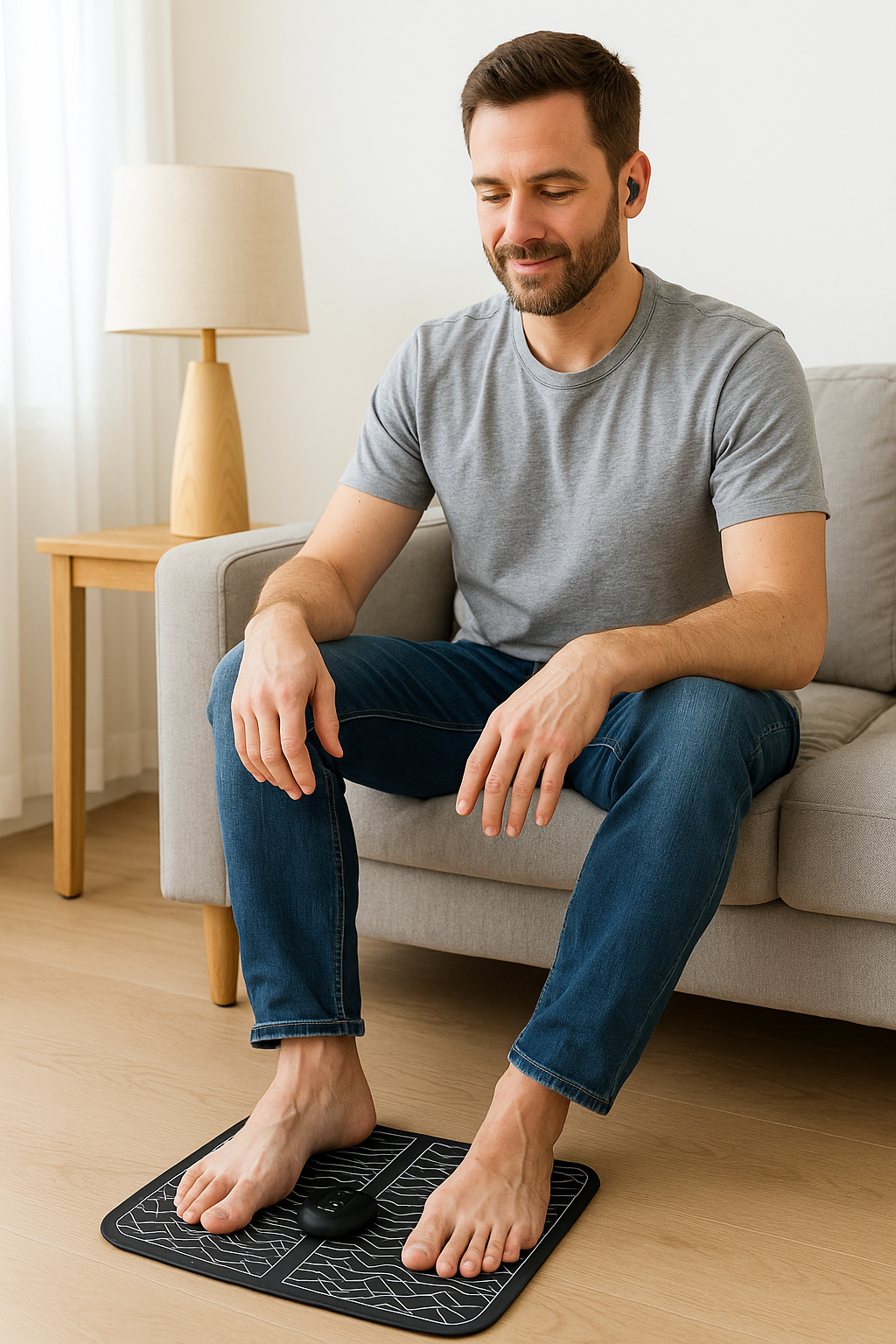EMS foot massagers have become increasingly popular among people looking to relieve fatigue, improve circulation, and ease muscle tension after a long day. These devices use Electrical Muscle Stimulation to send gentle impulses through the feet, causing the muscles to contract and relax much like during physical movement.
But the real question is: do EMS foot massagers really work, or are they just another wellness trend with exaggerated claims? In this article, we’ll take a closer look at how EMS technology functions, what scientific research says about its effectiveness, and what kind of results you can realistically expect from using one regularly.
How does EMS technology work in foot massagers?
EMS, or Electrical Muscle Stimulation, is a technology that uses gentle electrical impulses to activate nerves and muscles. In foot massagers, this process is designed to mimic the natural contractions that occur when you walk or move, helping to stimulate circulation, reduce tension, and promote recovery.
The device works through conductive pads or gel surfaces that come into contact with the soles of your feet. When you turn the massager on, it sends low-frequency electrical pulses through the skin. These impulses travel along nerve pathways, causing the muscles in your feet and lower legs to contract and relax rhythmically.
This stimulation improves blood and oxygen flow to the tissues, which helps nourish the muscles, reduce swelling, and flush out waste products like lactic acid. It’s the same principle used in physiotherapy treatments, where controlled electrical currents help restore muscle function and relieve discomfort.
The intensity and frequency of the impulses can usually be adjusted according to your comfort level. Lower settings produce a light, tingling sensation that promotes relaxation, while higher settings create stronger contractions that target muscle recovery and circulation.
Unlike traditional massage devices that rely on mechanical rollers or vibration, EMS foot massagers don’t require physical pressure. Instead, they activate muscles from within providing a deeper and more targeted form of stimulation that reaches areas manual massage often can’t.
Regular use helps improve muscle strength and nerve responsiveness, particularly in individuals with sedentary lifestyles or poor circulation. For older adults, people with diabetes, or those recovering from injuries, this type of therapy can enhance mobility and reduce the feeling of heaviness or fatigue in the legs.
In simple terms, EMS technology transforms electrical energy into therapeutic muscle movement, boosting circulation and relaxation without any physical effort. It’s a safe, low-impact way to keep your feet and legs active, energised, and pain-free.
What results can you expect from using an EMS foot massager?
When used consistently and correctly, an EMS foot massager can deliver noticeable improvements in both comfort and overall foot health. While results vary from person to person, most users experience benefits such as better circulation, reduced swelling, pain relief, and deeper relaxation within just a few weeks of use. Understanding what results to expect helps you get the most out of this simple yet effective device.
Improved blood circulation
One of the most immediate results of using an EMS foot massager is enhanced blood circulation. The electrical impulses stimulate the muscles to contract and relax repeatedly, imitating the natural motion of walking. This rhythmic activity encourages blood flow back toward the heart, helping to prevent fluid retention and cold feet.
After consistent use, users often notice that their legs feel lighter and less tired. Those who suffer from poor circulation, such as older adults or people with sedentary lifestyles, report a visible reduction in swelling and discomfort within two to three weeks.
Relief from pain and muscle fatigue
Another key benefit is pain relief, particularly for people struggling with chronic foot tension or conditions like plantar fasciitis, neuropathy, or general soreness. EMS works by stimulating sensory nerves, which help block pain signals sent to the brain.
Within a few sessions, you can expect a decrease in stiffness and soreness in the feet, calves, and ankles. Regular use also reduces muscle fatigue caused by standing or walking for long hours. Some users describe the sensation as a deep, soothing relief that relaxes the entire lower body.
Reduced swelling and inflammation
Poor circulation and inactivity often lead to fluid build-up in the feet and ankles. EMS foot massagers encourage lymphatic drainage — the process that removes toxins and excess fluids from the tissues. After consistent use, most people experience less swelling, especially in the evenings or after prolonged sitting.
This improvement not only enhances comfort but also supports healthier skin and better flexibility in the ankles and toes.
Stronger and more responsive muscles
Over time, an EMS foot massager can also help strengthen foot and calf muscles. The low-frequency contractions act like a gentle workout, helping maintain muscle tone and improving stability.
This is especially valuable for seniors or individuals recovering from injury, as it keeps the muscles active without putting strain on the joints. Regular use can improve balance, coordination, and overall lower-body strength.
Deep relaxation and reduced stress
Beyond the physical results, EMS foot massagers offer powerful mental relaxation benefits. The rhythmic pulses stimulate the parasympathetic nervous system the body’s “rest and recover” mode — which helps reduce stress hormones like cortisol.
After a long day, a 15–20 minute session can relieve mental tension, improve mood, and even promote better sleep. Over time, the consistent relaxation effect contributes to overall well-being and improved recovery from daily stress.
Long-term results and maintenance
The full results of using an EMS foot massager are typically seen after several weeks of regular use. Improvements in circulation, muscle tone, and pain relief tend to build gradually and become more noticeable with consistent sessions.
To maintain these benefits, it’s best to use the device for 15–20 minutes per day, several times per week. Pairing EMS therapy with hydration, light exercise, and stretching enhances the long-term effects.
How long does it take to see results from an EMS foot massager?
The time it takes to see results from an EMS foot massager depends on several factors, including your health condition, how frequently you use it, and the intensity level you choose. While some people notice benefits after just a few sessions, others may need a few weeks of consistent use to feel lasting improvements.
Most users begin to notice subtle changes within the first one to two weeks, such as lighter feet, reduced stiffness, or a more relaxed sensation after each session. Over time, these effects become stronger as circulation improves and muscles respond to regular stimulation.
Here’s a general idea of what to expect over time when using an EMS foot massager consistently:
-
After a few sessions:
Many users feel an immediate sense of relaxation and lightness in the feet and calves. The gentle electrical pulses help relieve tension and stimulate blood flow, offering quick comfort after long periods of standing or sitting. -
After one to two weeks:
With daily or near-daily use, circulation starts to improve more noticeably. You may experience warmer feet, reduced swelling, and less fatigue. People with mild discomfort or poor circulation often start to feel more energised at this stage. -
After three to four weeks:
The results become more visible and lasting. Regular stimulation strengthens muscles, improves nerve response, and further enhances blood and lymph flow. Users report less swelling, better mobility, and greater overall comfort in the legs. -
After a month or more:
Consistent use leads to long-term improvements in muscle tone, recovery, and relaxation. Many people find that foot and leg pain is significantly reduced, and daily activities feel easier and more comfortable.
To maintain these benefits, it’s best to use your EMS foot massager for 15–20 minutes per day, at least three to five times per week. Combined with hydration, light exercise, and good posture, it helps ensure lasting results for healthier, more energised feet.
Conclusion
Yes, EMS foot massagers really work. By using gentle electrical impulses to stimulate the muscles and nerves in your feet, they help improve circulation, reduce swelling, ease pain, and promote deep relaxation. Regular use can make a noticeable difference in how your feet and even your legs feel each day.
For people who suffer from poor circulation, chronic fatigue, or muscle tension, an EMS foot massager provides a simple, non-invasive way to restore comfort and mobility. It’s also a great tool for athletes and office workers alike, offering recovery and relaxation from daily strain.
While results depend on consistency and individual health, most users experience positive effects within just a few weeks of use. When paired with hydration, stretching, and light activity, the benefits last even longer.
In short, an EMS foot massager is more than just a wellness gadget it’s a proven method to revitalise tired feet, improve overall circulation, and support long-term well-being.



Are ems foot massagers good for you?
What does EMS do for your feet?